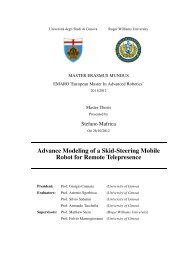CAMPUS PLANNING - Roger Williams University
CAMPUS PLANNING - Roger Williams University
CAMPUS PLANNING - Roger Williams University
You also want an ePaper? Increase the reach of your titles
YUMPU automatically turns print PDFs into web optimized ePapers that Google loves.
2002-2003 RWU Presidential Fellowship Report: Campus Planning<br />
The Master Planning Process<br />
Primary Steps:<br />
1. Create a Vision<br />
2. Establish a Team<br />
3. Establish a Process<br />
4. Develop a Campus Plan<br />
5. Implement the Plan<br />
6. Conserve and Maintain the Vision<br />
7. Repeat as necessary<br />
As the outline above indicates I am placing the Campus<br />
Plan within the context of a larger Master Planning Process<br />
in order place emphasis on the unique role of the "Plan" as<br />
something which can give real physical expression to the<br />
goals and aspirations of the <strong>University</strong>, something that<br />
transcends the immediate private concerns of any one body<br />
and looks at the physical environment in a comprehensive<br />
way. It links past and future, natural and manmade (nature<br />
and culture) and offers and clear vision for the future form<br />
of the institution. I realize that in placing so much<br />
importance on the plan I am setting rather high<br />
expectations; but I am doing so with the knowledge that, in<br />
an ideal sense, the campus plan is but one component of the<br />
physical design process. There should be precinct plans and<br />
ultimately individual building site plans. All of these<br />
inform, elaborate and even modify the "Campus Plan". Yet,<br />
a good Campus Plan has the power to inspire future<br />
designers for generations to come. Our plan will reference<br />
past plans and there will be other plans to overlay this one.<br />
1. The Vision<br />
Mission<br />
“<strong>Roger</strong> <strong>Williams</strong> <strong>University</strong> is a community<br />
devoted to teaching and learning wherein students<br />
pursue both personal and intellectual growth. The<br />
<strong>University</strong>’s mission is to teach students to think,<br />
reason, and communicate; to develop expertise in<br />
their chosen fields of study; to appreciate<br />
established disciplines and to investigate<br />
interdisciplinary connection; to experience study<br />
and life abroad; to value cultural diversity; to<br />
develop ethical awareness; and to preserve<br />
intellectual curiosity throughout a lifetime.”<br />
“<strong>Roger</strong> <strong>Williams</strong> <strong>University</strong> is committed to the<br />
creation and delivery of distinctive undergraduate<br />
and graduate programs that involve discovery and<br />
curiosity and that are characterized by an ethos of<br />
inquiry and civic responsibility.”<br />
More recently, <strong>Roger</strong> <strong>Williams</strong> <strong>University</strong>’s President Roy<br />
J. Nirschel defined the “core values” at the center of the<br />
<strong>University</strong> mission as follows:<br />
6
















